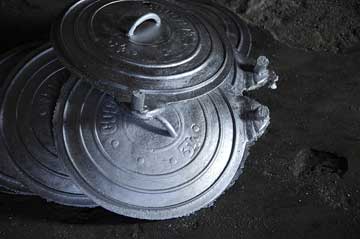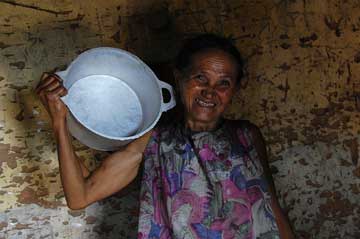Impoverished metal workers in Madagascascar recycle to earn a living
Metal Workers in Madagascar recycle to earn a living
Julie Larsen Maher
July 6, 2007
A ride across the Madagascar countryside can feel like stepping back in time on this tropical island off the east coast of Africa. There is no bustle of big cities. The Malagasy, as the people of Madagascar are known, live much like their forefathers in small communities where traditions are passed down through the generations. They live without any contemporary conveniences including running water, electricity, automobiles, televisions, or even shoes. They commute on foot, or with larger loads, in a wooden cart pulled by zebu, a type of large, bony oxen. Their houses are mostly constructed from available materials including sticks or bricks of dried mud collected from surrounding rice fields.
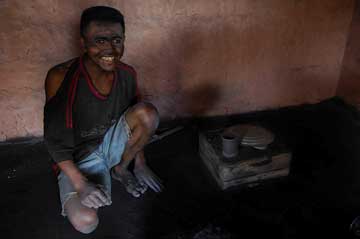 © Julie Larsen Maher Photography tip from Julie Larsen Maher, staff photographer for WCS: I photographed the rice pot production and people with a Nikon D2Xs digital SLR camera in ambient light in an effort to bring to viewers closer to the reality and raw beauty of the scenes. As noted, it is rare to find electricity on journeys in Madagascar for downloading, so I take along many Lexar flash cards so I don’t miss a moment. |
Madagascar is also a country of unique biodiversity, lemurs and chameleons to name a few, and much of which exists nowhere else on earth. Poverty, population growth, and unsustainable resource use pose continuing threats to the people and the wildlife. Over 80% of Madagascar’s forests are gone, and preserving those that remain is a global priority.
Rice is the Malagasy food staple, the main course three times a day at their meals. They grow rice themselves or shop for it, and their other supplies including aluminum rice cooking pots, in open-air markets that are their cultural centers.
Tucked away in Ambatolampy, a small town in central Madagascar, is the source of traditional manufacturing of the aluminum rice pots used all around the country. Rather than a massive, high speed production line, ten Malagasy people working in teams of two in a yard surrounded by one room buildings, make about 40 rice pots a day as both an economic means and a way of providing necessary goods for day-to-day life.
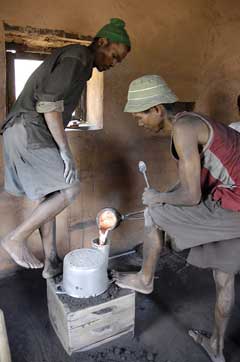 © Julie Larsen Maher |
It is a labor-intensive job. The melting of metal and making of the pots is assigned only to men, who work in extreme heat with no electricity or water—and no shoes. Their faces are etched with remnants of their day’s work.
Recycled aluminum from old fuel tanks is cut and liquified by hand in hot charcoal fires to begin the process.
Once the aluminum reaches its melting point, it is handed off to one of the teams of men to pour into a mold prepared from black volcanic dirt found only in the rice fields on the hillsides surrounding Ambatolampy. The special dirt is stomped into place with bare feet.
A pot is complete in only minutes, and still hot to the touch, it moves onto the finishing building where the women are allowed to work. Rough edges are rasped or sawed off with a hack saw. The finishing room is considered less physical and better adapted to a woman’s role, although it appears to be as difficult and dangerous as the making of the pot itself. The 54-year old woman who is the lead “finisher” of the rice pots, is petite, except for her biceps, which, after 20 years of sawing edges off lids and pots, are bigger than those of a professional athlete. She looks years beyond her age.
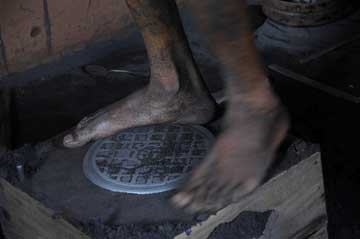
|
The pots are only available by wholesale order for 10,000 ariary each (the equivalent of $5 U.S. dollars.) They are carted away and sold in markets around the country alongside harvested rice.
Madagascar is recovering from a recent series of deadly cyclones and tropical storms, one of the worst cyclone seasons in years. Floods and famine are affecting this already poverty-stricken country which is ranked among the poorest in the world. The Malagasy government estimates nearly a half million people have been affected by the resulting damage of the storms that have devastated the communities in remote areas of Madagascar. Farm families have lost their crops just before harvest, and many homes have been destroyed. Rice fields were especially hard-hit risking food security.
Conservationists are still assessing the damage but say that crop losses and destruction of buildings could put pressure on protected rainforest areas due to villagers seeking timber for reconstruction and wildlife meat to replace lost agricultural crops.
Also by Julie
Dodging leeches in Madagascar’s unexplored rainforest
It is called a rainforest for a reason—because it rains…. and rains. As my field partner, Angelin Razafimanantsoa, and I make our way down muddy mountainsides in the endless downpour, we stop only long enough to pick squirming, bloodthirsty leeches off each other’s face. Hours pass as we wade through knee-deep streams rushing over smooth, slippery rocks and thick forest stands. Seven hours ago, we anticipated arriving at our next base camp in three hours’ time. Now, as night is falling, it seems we have at least five hours more to go.
